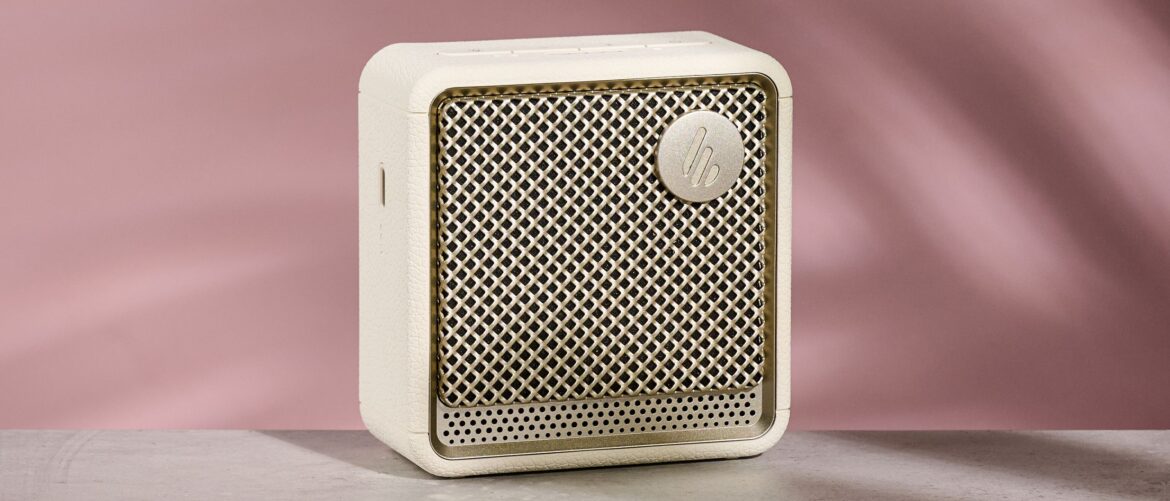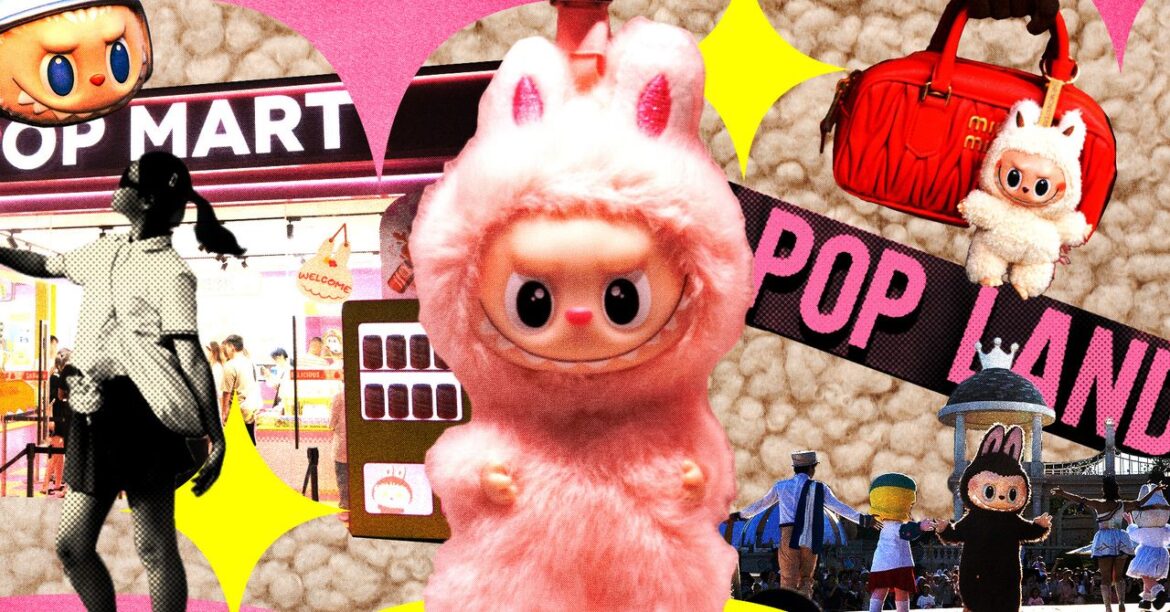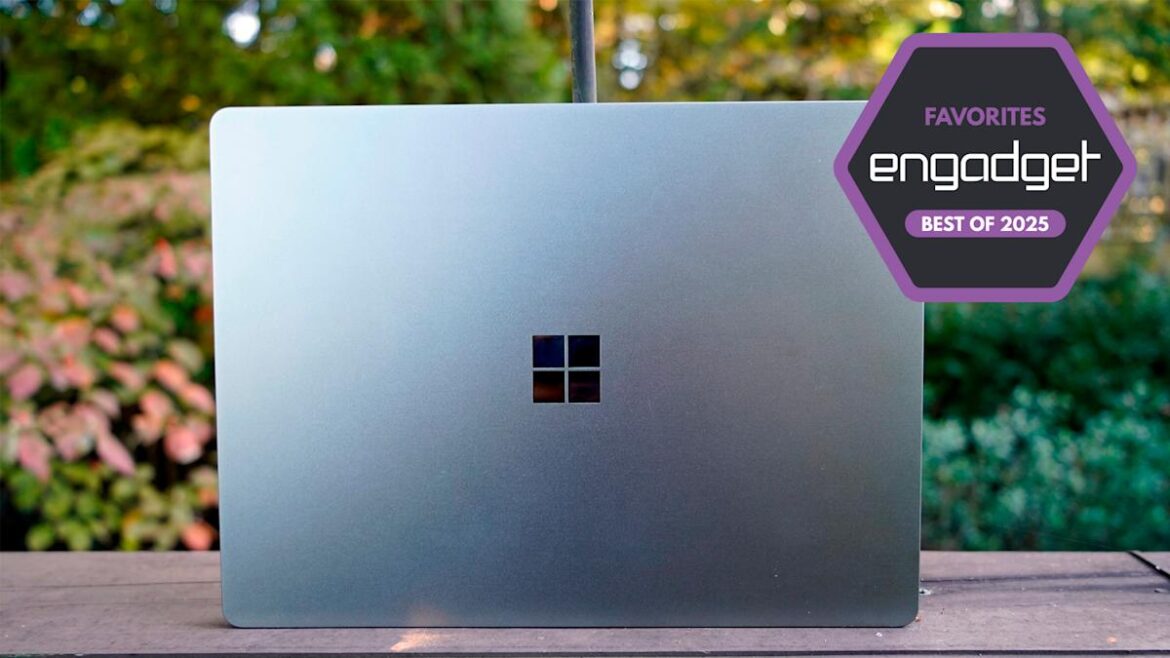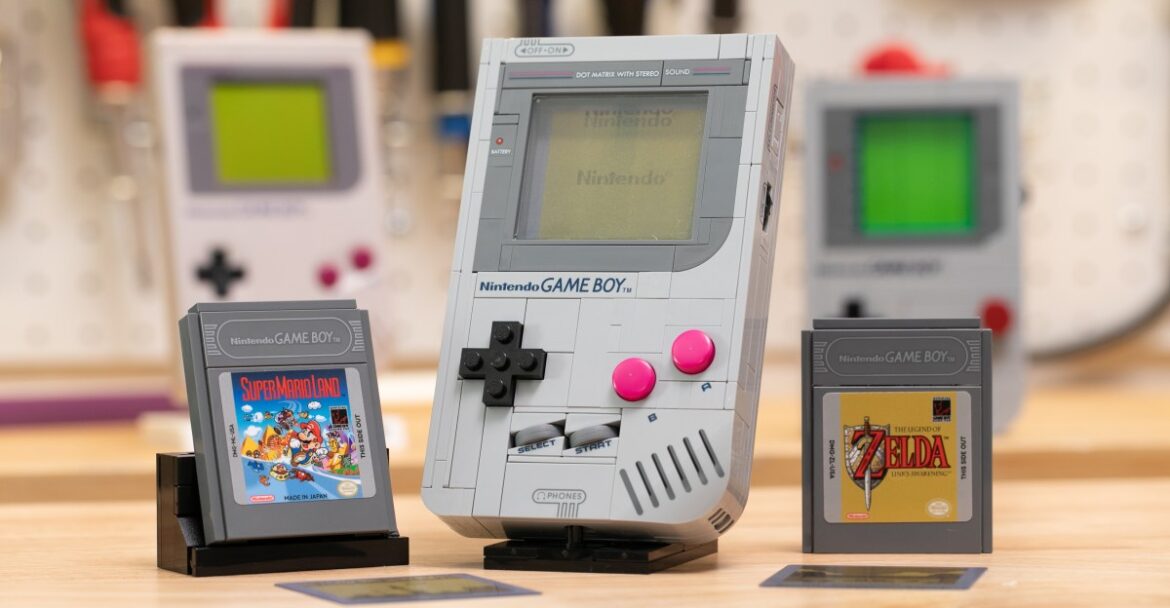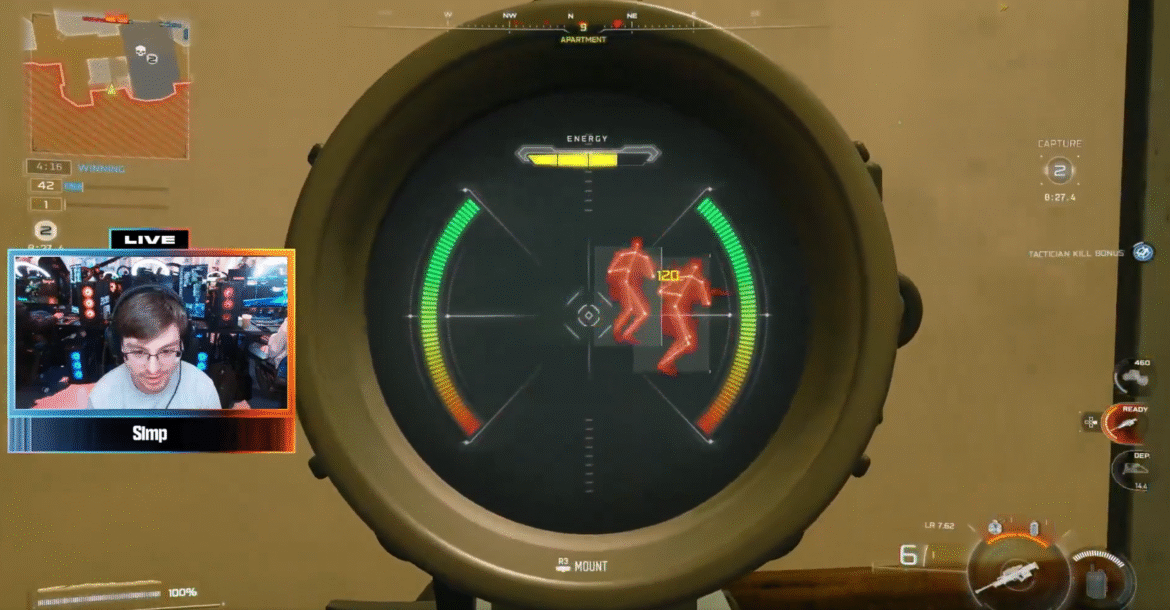Why you can trust TechRadar
We spend hours testing every product or service we review, so you can be sure you’re buying the best. Find out more about how we test.
Edifier ES20: two-minute review
I’ll be honest, the Edifier ES20 took me off guard. This super-small Bluetooth speaker is powered by a 6W driver and is less than 10cm in height and width. But it really does punch above its weight. And not only sonically – also in terms of its looks, feature-set, and battery life.
Yep, this tiny, square-shaped model impressed me in almost every area. Let’s start where it matters most: audio quality. Largely due to its physical limitations, the Edifier ES20 isn’t capable of deep rippling bass or ultra-imposing loudness, but there’s still a lot to love. Bass response is rapid and impressively deep, but mids never feel obscured, while instruments in the treble range come through sounding controlled, yet expressive.
OK, the Edifier ES20 only makes use of the SBC codec – a lot of the best Bluetooth speakers would offer AAC, and maybe LDAC for good measure. But still, I was impressed with the clarity of my favorite tracks. If you want a more nuanced listen, you could pair a second ES20 up for stereo sound.
Another area the ES20 impressed me in was the looks department. It has a retro vibe to it, similar to models like the Marshall Willen II, or speakers from Klipsch. I’m a big fan of that, and when you pair its classy aesthetic with appealing (and customizable) ambient lights, this thing really has it all.
There’s even more to love, though. 15 hours of playtime is very solid – that’s a couple more hours than a lot of rivals in this weight class can offer. In addition, I was a fan of the ES20’s modest price point, especially in the UK and Australia – for reference, it’s $89.99 / £49.99 / AU$99.99.
Just generally, it has everything you’d want from a model like this. It’s compact, light, IP67 dust and waterproof rated, and great-sounding. There are some small imperfections worth noting, though. Firstly, the sound of the ES20 is noticeably compressed at peak volumes, especially when you crank things up all the way to 100%. That’s common for small speakers, and I’d recommend getting a larger model anyway if loudness is your aim – the Bose SoundLink Flex Gen 2 is a still-compact but significantly more powerful pick.
Another thing is that the ES20’s EQ options are seriously lacking. There are four modes: Music; Gaming; Movies; and Outdoor. I don’t think that having a single ‘Music’ calibration is enough – especially when there’s no custom option and the modes that are here sound a little too similar to one another.
Still, it’s important to look at the bigger picture. And that tells me that the Edifier ES20 is an excellent small-sized speaker that really nails it where it matters. Sure, the EQ options are lacking, but the default tuning sounds plenty good enough. Tie that together with luxurious looks, a generous helping of battery life, and wonderful waterproofing, and the Edifier ES20 is easy to recommend.
(Image credit: Future)
- Edifier ES20 at Amazon for $89.99
Edifier ES20 review: price and release date
- $89.99 / £49.99 / AU$99.99
- Launched in June 2025
The Edifier ES20 was launched in June 2025 as part of Edifier’s new ‘ES’ range. That apparently stands for ‘Elegant’ and ‘Superb’, or ‘Edifier Sound’. Anyway, enough of that! This speaker has a list price of $89.99 / £49.99 / AU$99.99, meaning it’s a fair bit more pricey in the US, compared to other territories – more on that later. You can purchase the ES20 in either black or white.
Edifier ES20 review: specs
Swipe to scroll horizontally
Drivers
1x 43mm full-range driver
Dimensions
3.6 x 3.7 x 2 inches / 90.4 x 93.7 x 49.7mm
Weight
0.7lbs / 326g
Connectivity
Bluetooth 5.4
Battery life
15 hours
Waterproofing
IP67
(Image credit: Future)
Edifier ES20 review: features
- Effective hands-free mic with noise cancelling tech
- Attractive and personalizable ambient lighting
- Weak EQ options
The Edifier ES20 offers a fairly hearty helping of features considering it’s a small, affordable Bluetooth speaker.
First of all, you get multi-point connectivity, if you want to link multiple devices to your speaker. In addition, you can pair two ES20 models together and unlock stereo audio, if you’re looking for a more nuanced and powerful audio presentation.
There’s also an inbuilt microphone – something you won’t see in all Bluetooth speakers nowadays. Edifier described it as a “high sensitivity” mic, which harnesses the power of noise cancellation for clear, hands-free calling. And largely, I’d say that’s exactly what you get. My voice sounded clear, even when I stood quite far from the speaker – though there was some noticeable sibilance.
Perhaps the most interesting feature, though, is the speaker’s customizable ambient lighting. Using the Edifier ConneX app, you can pick from a range of lighting options, including: Breathing; Rainbow; Static; Glittering and Colorful; or Emergency Light. This visual aspect only enhances immersion into your music, and the option to personalize aspects like light modulation rate, brightness, and the displayed colors, is a nice touch.
If you do make use of the ambient lighting – it can be disabled entirely, if you’d prefer – it will drain the speaker’s battery at a more rapid rate. Speaking of, you get up to 15 hours of playtime from the ES20, which is pretty good, actually. That’s more than rivals like the JBL Clip 5 and the LG xboom Go XG2T can dream of.
This lil’ fella’s on a roll so far… but I’m gonna have to burst its bubble a bit. And that’s down to one thing in particular – EQ options. There are four here: Music; Gaming; Movies; and Outdoor. Unfortunately, I wasn’t hearing a whole lot of difference between these. On top of that, there’s no custom multi-band equalizer to make use of – something I would have appreciated, personally. This isn’t a totally crushing miss – largely thanks to the ES20’s impressive audio output…
(Image credit: Future)
Edifier ES20 review: sound quality
- Punchy, rapid bass response
- Controlled treble, well-balanced mids
- Some distortion at peak volume and no fancy audio codecs
Yes, I was very impressed with the Edifier ES20’s sonic performance – especially given its incredibly compact build. It’s powered by a 43mm full-range driver, makes use of a 55mm passive radiator, and has a maximum power output of 6W. That doesn’t sound like a lot – but this small speaker is more mighty than you may expect.
When bumping Burning Down by Dimmish, the rapid, thumping bass was replicated responsively and impactfully. Sure, the ES20 couldn’t quite match the depth you’d expect from some of the best party speakers, but that’s to be expected due to its physical limitations. With the ES20, you’re not putting up with the ‘boomy’, muddy low-frequency performance of many budget competitors – it’s punchy, as Edifier claims.
In addition, Burning Down showcased the controlled yet expressive nature of the ES20’s treble output. Higher-pitched percussion wasn’t overly forward in the mix, and it never sounded tinny or harsh, even at mid-to-high volume levels. Instead, it was tonally accurate, disciplined, and clean.
I’d say the ES20 certainly has a warm sound signature, really leaning into that ‘mightier than it looks’ angle. But even still, bass isn’t overbearing, meaning that in tracks like Each Time You Pray by Ned Doheny, I was still treated to clear, well-balanced vocals and neatly defined acoustic guitar.
You won’t get the most nuanced, detailed listen in the world, especially if you’re only using one ES20 rather than two – which can be used in stereo mode. For instance, in Minute by Minute by The Doobie Brothers, I wasn’t wowed by next-level instrument separation between the groovy bass, synths, and McDonald’s iconic vocals. The speaker also uses the most basic SBC Bluetooth audio codec, so don’t expect to see LDAC or aptX support.
Then again, it’s important to emphasize that this is a very small model – so you can’t expect the most expansive soundstage or the effortlessly layered sound you’d uncover on premium, larger models.
Both music and podcasts come through very clearly on the ES20, and unless you push the volume up to 90-100%, you won’t be subjected to distortion or overly compressed audio. That’s about as much as you can ask for from a sub-$90 / £50 / AU$100 speaker of this stature!
(Image credit: Future)
Edifier ES20 review: design
- Gorgeous retro-style design
- Fantastic protection against the elements
- Attractive lighting
The Edifier ES20 is an absolute beauty, and looks much more luxurious than its modest price tag would suggest.
It’s got an almost Marshall-style retro look to it, with an appealing speaker grille protecting the driver, and a faux leather material used for the outer casing and button controls. Yep, there’s nothing about this that screams cheap. You can scoop it up in either Black or White – we went for the latter, but both compliment the speaker’s classy looks brilliantly.
On top of this, the reverse side of the speaker has ambient lighting, which can illuminate a wall behind it, for example, adding a bit of visual flare to your listening experiences. As I mentioned earlier, the lights are highly customizable through the Edifier ConneX app, and if you’d prefer to have them off, you can.
This model’s not only a pretty face, though, it’s also highly practical. Firstly, it’s very small, coming in at less than 10cm wide and tall, and just over 300g in weight. It also comes with a fabric carry strap, so you can easily attach it to a backpack, for example.
Crucially, it’s also very well protected against the elements, thanks to its IP67 rating. That means it’s plenty dustproof, but can also be submerged in up to a meter of water for 30 minutes. Not bad, is it?
Combine all of this with well-sized on-board controls, small rubber feet for added stability, and a handy LED light strip to indicate battery life, and the ES20 nails it in every way.
(Image credit: Future)
Edifier ES20 review: value
- Pricing a little inconsistent across territories
- But regardless, you’ll get plenty of bang for your buck
- Rivals are playing in a similar ballpark, price-wise
The Edifier ES20 isn’t all too expensive, even considering its small size. Actually, I have been tempted to refer to it as ‘cheap’ once or twice in my review, had it not been for its US pricing.
See, the ES20 comes in at £49.99 in the UK and AU$99.99 – fairly even pricing across the territories using current exchange rates. But in the US, this model costs $89.99, which isn’t so proportional. This may be down to the tariffs imposed by the US government earlier in 2025, but still, it means the ES 20 is more mid-priced, than cheap, for a speaker this small.
After all, a top-class rival like the JBL Clip 5 has a list price of $79.95 (£59.99 / AU$89.95), but can often be found for under $60 now. Still, its most similar competitor, the Marshall Willen II will generally cost more than $100, so you’re still not overpaying for the ES20 – it’s just that you’re getting even more bang for your buck outside of the US!
Speaking of, this speaker has qualities that far outstrip a range of competitors in its price and weight class. It offers genuinely punchy, largely distortion-free sound, gorgeous looks, and plenty of playtime. Combine that with its IP67 rating and ambient lights, and you’re looking at awesome value for money.
(Image credit: Future)
Should I buy the Edifier ES20?
Swipe to scroll horizontally
Attributes
Notes
Rating
Features
Ambient light options, multi-speaker pairing, good mic and battery life, but EQ options a little lacking.
4.5/5
Sound quality
Punchy, clear audio with a bass-forward sound signature, SBC only and some compression at peak loudness.
4/5
Design
Gorgeous retro looks, amazing waterproofing, appealing lighting.
5/5
Value
Despite slightly disproportionate US pricing, remains affordable and has plenty of quality.
4.5/5
Buy it if…
Don’t buy it if…
Edifier ES20 review: also consider
Swipe to scroll horizontallyHeader Cell – Column 0
Edifier ES20
JBL Clip 5
Ultimate Ears Miniroll
Price
$89.99 / £49.99 / AU$99.99
$79.95 / £59.99 / $89.95
$79 / £69 / AU$99
Drivers
1x 43mm full-range driver
1x Integrated class D digital amplifier
46.8mm active driver
Dimensions
3.6 x 3.7 x 2 inches / 90.4 x 93.7 x 49.7mm
3.4 x 5.3 x 1.8 inches / 86 x 134.5 x 46 mm
4.8 x 4.1 x 1.9 inches / 122 x 105 x 48mm
Weight
0.7lbs / 326g
0.6lbs / 285g
0.6lbs / 279g
Connectivity
Bluetooth 5.4
Bluetooth 5.3
Bluetooth 5.3
Battery life
15 hours
12 hours
12 hours
Waterproofing
IP67
IP67
IP67
How I tested the Edifier ES20
(Image credit: Future)
- Tested over the course of one week
- Mainly used in the music testing space at Future Labs
- Predominantly tested using Tidal
I spent hours with the Edifier ES20, during which time I listened to music, tuned into podcasts, and took a couple of phone calls. I exhausted all of the ES20’s features, tried all of its light customization options, and tried listening at various distances and angles.
For the most part, I used the ES20 in our music testing room at Future Labs. Here, I went through the TechRadar testing playlist, which features tracks from a range of genres. I also listened to songs from my personal library – mainly via Tidal, but sometimes on Spotify.
More generally, I’ve reviewed dozens of speakers, headphones, earbuds, soundbars, and more here at TechRadar, where I have a particular focus on audio-visual technology. I’ve tested most of the ES20’s competition, so I know what it takes for a speaker to stand out in a highly convoluted market.
- First reviewed: September 2025
- Read more about how we test
Edifier ES20: Price Comparison

